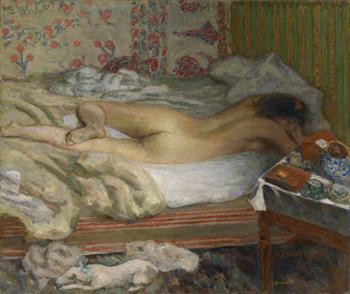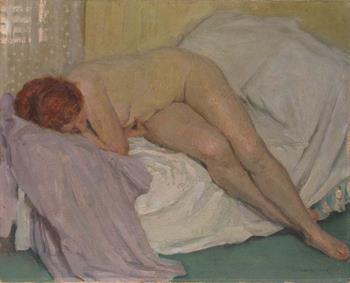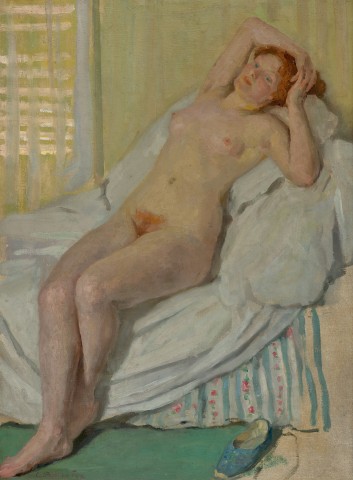REPOS, c.1909 – 11
EMANUEL PHILLIPS FOX
oil on canvas
98.5 x 71.0 cm
signed lower left: E Phillips Fox
signed and inscribed with title on artist’s label verso: R [illeg.] E. Phillips Fox/ £ 20
bears inscription verso: Charles Bush / coll / BUSH
Charles Bush, Melbourne (inscribed verso)
Sotheby’s, Melbourne, 22 August 1994, lot 63 (as ‘Le Repos (Resting)’)
Private collection, Perth
Deutscher~Menzies, Melbourne, 1 May 2002, lot 68 (as ‘Le Repose’)
The Cbus Collection of Australian Art, Melbourne, acquired from the above
Possibly: Salon de la Société Nationale des Beaux Arts, (New Salon), Grand Palais, Paris, 16 April – 30 June 1911, cat. 529
Possibly: 30e Exposition de la Société Internationale de Peinture & Sculpture, Galerie Georges Petit, Paris, 6 – 31 December 1912, cat. 48
Possibly: Catalogue of Pictures by E. Phillips Fox, Athenaeum Hall, Melbourne, 17 June – 4 July 1913, cat. 27 (as ‘Repose’)
Possibly: Pictures by E. Phillips Fox, The Royal Art Society, Sydney, 13 – 28 October 1913, cat. 23 (as ‘Repose’)
Australian Art/ Colonial to Contemporary, Deutscher Fine Art, Melbourne, May – June 1995, cat. 29 (illus. in exhibition catalogue)
E. Phillips Fox & Ethel Carrick, Deutscher Fine Art, Melbourne, 13 November – 6 December 1997, cat. 19 (illus. in exhibition catalogue, p. 24)
Figurative Works from the Cbus Collection, Latrobe Regional Gallery, Victoria, 4 August – 2 December 2012
Zubans, R., E. Phillips Fox: His Life and Art, The Miegunyah Press, Melbourne 1995, cat. 343
de Vries, S., Ethel Carrick Fox: Travels and Triumphs of a Post-Impressionist, Pandanus Press, Brisbane, 1997, p. 64 (illus., as ‘Repose (Le Repos)’, c.1911)
Nainby, B., Stanhope, Z., and Furlonger, K., The Cbus Collection of Australian Art, in association with Latrobe Regional Gallery, Melbourne, 2009, pp. 18, 35 (illus.), 219 (as ‘Le Repose’)
Nude, 1909 – 1911, oil on canvas, 49.5 x 60.3 cm, in the collection of The Art Gallery of Western Australia, Perth
Resting, c.1910 – 1911, oil on canvas, 65.0 x 81.3 cm, in the collection of the Queensland Art Gallery, Brisbane
Emanuel Phillips Fox married English born Ethel Carrick in 1905, after meeting her at the artists’ colony of St Ives in Cornwall. Carrick had studied at the Slade School of Fine Art in London and had clear artistic aspirations, as well as a strong independent streak, and Fox had undertaken his training at Melbourne’s National Gallery School, alongside Rupert Bunny and Frederick McCubbin. Together the couple shared a rich, creative life, supporting each other in their respective artistic endeavours and ambitions. As newlyweds they moved to Paris, living in a studio apartment at the Cité Fleurie in Montparnasse, described by Carrick as ‘quite a cosmopolitan little colony of hard-working artists … thirty different nationalities being represented.’1
220260 Pierre BONNARD-Siesta.jpg

Colour and the varied effects of light were central to Fox’s art. Indeed, as Lionel Lindsay recalled, ‘He once told me that he no longer saw anything except as a colour-sensation… His gamut of greens is extraordinary fine and varied, and the purity of his colour still holds the sunlight imprisoned in the pigment.’2 While he had been trained in an academic style, Fox always enjoyed the freedom of working outdoors, and the influence of French Impressionism – particularly as articulated by Renoir and Monet, whose work was easily accessible during Fox’s years in Paris – encouraged this, feeding in to what has been described as his natural ‘inclination towards colour, light and optical experience.’3
The example of the French intimiste painters, Pierre Bonnard and Edouard Vuillard, was also significant. Focussing on the figure in intimate domestic settings, their paintings are quiet and contemplative in a manner which is almost timeless. Bonnard’s moody Siesta, 1900, acquired through the Felton Bequest by the National Gallery of Victoria in 1949, is a relevant comparison, sharing with Fox’s Repos, c.1909 – 11, both its subject – a naked woman alone in her boudoir – and an interest in the depiction of interior details and decoration. While the painterly representation of pattern is a primary element of Siesta, Fox limits the decorative details of his work to the upholstery of the chaise longue on which the figure reclines. A pattern of vertical blue and white stripes interspersed with delicate pink and floral motifs is just visible beneath the draped white sheet, and a glimpse of this same textile can also be seen in the closely related work, Resting, c.1910 – 11 (Queensland Art Gallery / Gallery of Modern Art). A single slipper, discarded by the model, rests on a band of soft green carpet in the foreground, but apart from these elements, the palette is restrained and limited to pale shades of cream, grey and white. This airy colouring allows Fox to focus on the representation of light and shade, and his skill is on full display in the shadows and bright highlights of the crumpled sheet, and the reflections that illuminate the window’s blinds.
HIGH RES TIFF FOR E P FOX.jpg

Most prominent in this picture, however, is the nude who reclines comfortably, arms raised and hands clasped above her head. Although not overtly erotic, Fox’s depiction of the female figure is deliberately sensuous in its physicality, as well as the intimacy of the scene. The nude became an important aspect of Fox’s oeuvre during these years and as Ruth Zubans has noted, the lack of self-consciousness which characterised his approach to the theme could only have occurred in France.4 It was a genre that featured in exhibitions at the Salon and this, no doubt, also influenced Fox in his choice of subject matter, success in this context representing a significant achievement. When Fox was made an associate of the Société Nationale des Beaux Arts for Al Fresco, c.1904 (Art Gallery of South Australia), it both enhanced his status in Australia, as well as securing him a respected place among his international peers.5 Le Repos was shown at the New Salon at the Grand Palais in Paris in 1911, and in 1912 at the Exposition de la Société Internationale de Peinture & Sculpture. Fox took the painting to Australia when he returned the following year, showing it in exhibitions in Melbourne and Sydney, and it was here that it later found its first owner, a fellow artist, the painter Charles Bush.
1. Carrick Fox quoted in Goddard, A., ‘An Artistic Marriage’ in Art, Love & Life: Ethel Carrick and E Phillips Fox,
Queensland Art Gallery / Gallery of Modern Art, Brisbane, 2011, p. 18
2. Lindsay, L., ‘E. Phillips Fox’, Art in Australia, series 1, number 5, 1918 quoted in Zubans, R., E. Phillips Fox, National Gallery of Victoria, Melbourne, 1994, p. 1
3. Zubans, ibid., p. 3
4. Zubans, R., E. Phillips Fox: His Life and Art, The Miegunyah Press, Melbourne, 1995, p.155
5. Ibid., p.125
KIRSTY GRANT
